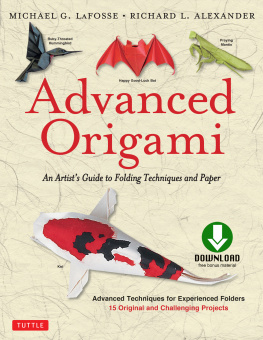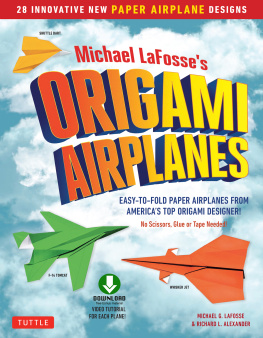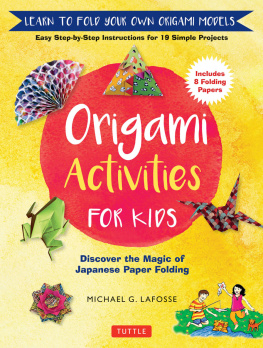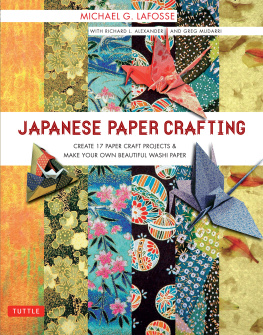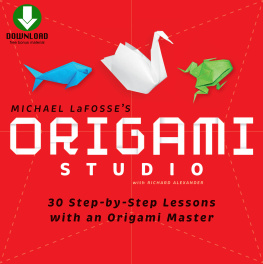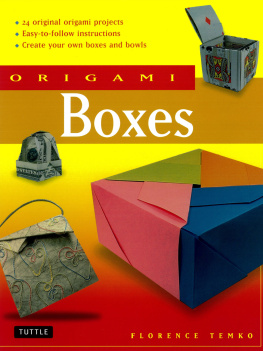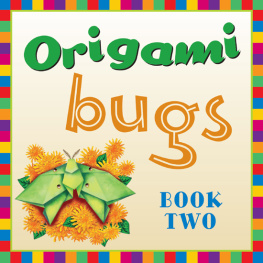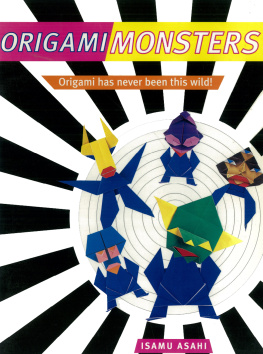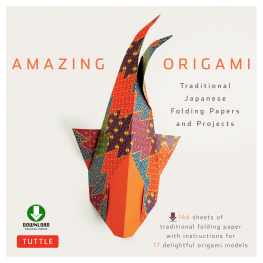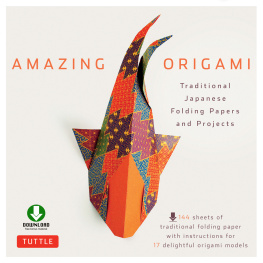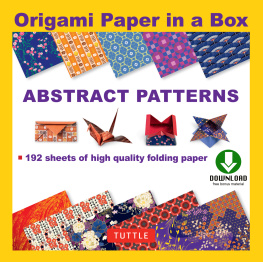ABOUT PAPER
Creating origami art takes more than just perfecting folding techniques. As I mentioned in the previous chapter, it also takes vision. An important part of achieving your vision is selecting the right paper for your model. Selecting the ideal paper complements your origami project. There is a great sense of satisfaction and triumph when you find the perfect paper. Although there are many hand papermakers around, most of them have other purposes and other types of customers in mind. Maybe your needs and goals will coincide with theirs, but with the complex model you have in mind the chances of that happening are slim. This is why we make our own origami papers and why we encourage you to do the same. Starting on page of this book, you will find a section on how to make your own paper. Although much time and effort are involved, the results can be stunning. But whether you create your own paper or not, it is still important to be aware of paper composition and available commercial papers.
PAPER QUALITIES
We deal with paper every day, but few paperfolding enthusiasts understand enough about the composition and manufacturing process of paper to know which paper is best for a particular project. Most folders use whatever paper is readily available, such as office paper, wrapping paper or those thin, brightly colored sheets of square-cut origami paper. Many believe that you must use origami paper if you are doing origami. When you are making origami art, focus on the art. Use real artists materials. So-called origami paper is an inexpensive craft-supply item designed to satisfy the casual hobbyist, crafter and grade-schooler. It is not formulated to be a lasting material for high-end, museum-quality paper art. Similarly, rarely will a hobbyist or origami crafter choose paper larger than a 10-inch (25-cm) square. Paper is by far the most limiting of the many limitations to good origami, yet the folders nearly always blame themselves! As a former chef, I like to use a cooking analogy: You cant make an exquisite angel food cake if you only have egg yolks and wholegrain flour. Get the right ingredients! Become familiar with paper types and qualities. Try to understand what makes a good piece of paper, or what makes a certain kind of paper right for your project. Here are some things to keep in mind when selecting paper for your origami.
Grain
The majority of fibers in a paper with grain lie in the same direction. Hold a small piece of the paper horizontally by one edge, then hold it by an adjacent edge. You will see that it droops more when held in one orientation because the fibers are generally aligned parallel to the greatest bend. (Think of the way that grass beach mats roll easily with the grain.) Grain is critically important to wet-folding. As cellulose fibers swell, they grow wider, not longer, just as a cactus, when watered, expands wider, not taller. Imagine what this does to a perfectly cut square piece of paper with pronounced grain when you wet it before folding.
Paper Strength
Paper strength is one of the most crucial elements in complex origami art. The strength of paper is related to fiber choice, length, suppleness and the characteristics achieved in the beating process. The ideal paper will have a high resistance to bursting and tearing. Paper strength can be rated when the paper is wet, and again when the paper is dry.
The extreme technical demands of todays super complex origami designs have also pushed the strength limits of readily available papers. Now our papers must be formulated to take numerous intricate creases. These additional stresses come not only from folding multiple layers multiple times, but modern origami artists are constantly turning portions of their models inside out to sink areas, or for clever color-change effects. Add to this the way that several of todays most popular origami models are action models with movement that often stresses the paper at key creases. In addition, now that the powerful and important technique of wet-folding has gained worldwide popularity, paper must be even stronger.
Fiber Choice and Blends
The source of the fiber and its processing dictates the qualities of the paper. Today, many communities recycle paper, and much of this fiber is processed so much that it becomes extremely short and weak. Without special chemical binding agents, much of the recycled fiber would be useless. The origami artist has a wide variety of fiber sources to consider, and each one has its strengths and weaknesses.
The most common paper fiber used in our archival papers is abaca. This fiber is from a plant in the banana family ( Musa textilis ) and is prized for its long, strong, relatively hard fibers. It may be the strongest known plant fiber! Cotton is at the other end of the spectrum, yielding a soft, fuzzy fiber that wicks moisture easily, making it one of the most desirable fibers to use in clothing, especially in humid, tropical climates. Other common plants used for hand paper-making include flax (linen), kozo (mulberry) and hemp. These fibers can be beaten to varying degrees, and blended in countless ways to produce a mind-boggling spectrum of handmade papers suitable for wet-folding. (See page for more on paper fibers.)
CHOOSING THE RIGHT PAPER
Realize that mastering any origami model requires a serious commitment on your part, and that you may have to fold the model many times. The paper you choose for a sketch, or rough draft, need not be expensive. We often work out designs on large rolls of inexpensive thin tracing or drafting thumbnail stock, called butter paper. A rough draft of your model may require foil or tissue-backed foil (see page ), which is a common tool for most complex origami designers. We also go through a huge amount of practice paperpaper that approximates the characteristics of the desired finished piece, but this paper may be seconds or machine-made paper readily available in art supply stores. You can purchase wide rolls of Fadeless brand paper, which is colored on one side and white on the other. It is ideal for practicea dress rehearsal that will allow you to explore your model in a larger scale than the sculpture you eventually desire.

Here is an example of a preliminary attempt, or practice piece, of my Big Brown Bat in red commercial paper before I folded it in higher-quality hand-made brown paper.
When learning a complex origami model, the search for just the correct paper for the final piece may take some time. Narrow your search for the correct choice by starting a collection of labeled scraps or samples, noting on each your likes and dislikes, successes or failures. All this searching and practice leads up to the big moment when you finally possess the skills, the vision and the perfect paper to execute your flawless rendition of that rascal skunk in your backyard!
Also keep in mind that after investing years of effort designing and executing a modern origami masterpiece, you want it to last, so the paper must be acid-free, or archival. Can you afford to take the chance of producing a piece of fine art using papers of unknown fiber content with questionable coloring agents or of dubious quality? And so we seek archival qualities in the paper, not only so that the colors will not fade but so that the sculpture will not disintegrate into dust from an acid attack. Perhaps there were great origami works in ages past that for one reason or another did not survive to the present. When you take proper care in making your own paper, you can be sure that your art will last for generations. That is the best reason for making your own paper.

